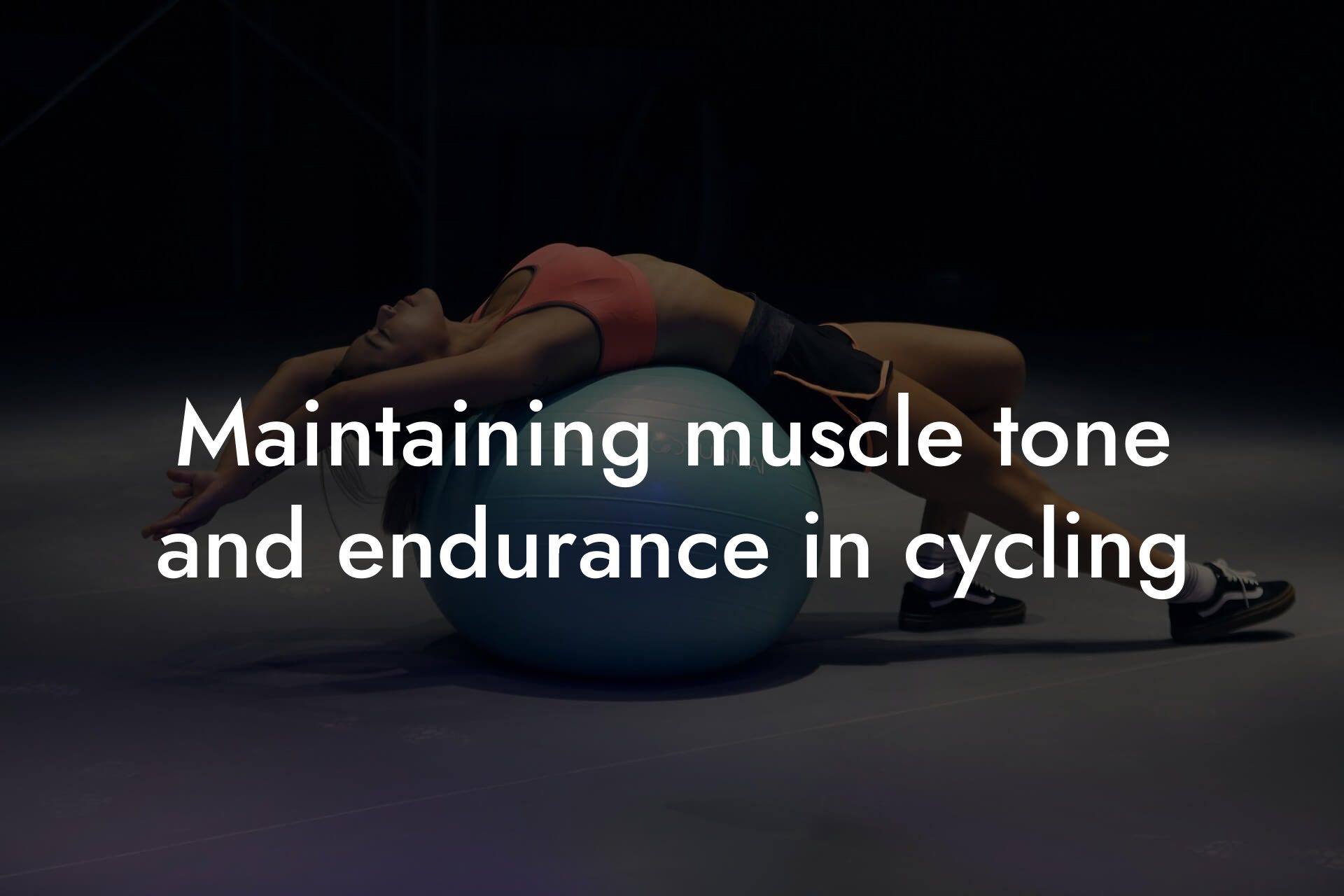As a high-earning professional, you understand the importance of maintaining a healthy physique to perform at your best in both your personal and professional life. Cycling is an excellent way to stay fit and healthy, but intense sessions can take a toll on your body. Proper recovery techniques are essential to help your body repair, rebuild, and adapt to the physical demands of cycling. In this article, we will explore the best recovery techniques for cyclists after intense sessions.
Table of Contents
Why Recovery is Crucial for Cyclists
Recovery is often overlooked, but it's a critical component of any training program. When you push your body to its limits, you cause micro-tears in your muscles, depletion of energy stores, and inflammation. If you don't allow your body to recover properly, you may experience fatigue, decreased performance, and increased risk of injury. Adequate recovery enables your body to repair and adapt, making you stronger and more resilient for your next ride.
Immediate Post-Ride Recovery Techniques
The first 30-60 minutes after an intense ride are crucial for recovery. During this time, your body is most receptive to replenishing energy stores and reducing muscle damage. Here are some immediate post-ride recovery techniques:
1. Stretching: Gentle stretching can help reduce muscle soreness and improve flexibility. Focus on your major muscle groups, such as your legs, hips, and lower back.
2. Hydration: Drink plenty of water or a sports drink to replenish lost electrolytes and fluids. Aim to consume at least 16-20 ounces of fluid for every pound of body weight lost during exercise.
3. Nutrition: Consume a balanced meal or snack that includes carbohydrates and protein within 30-60 minutes of your ride. This helps to replenish energy stores and support muscle repair.
Short-Term Recovery Techniques (0-48 hours)
In the hours and days following an intense ride, your body continues to recover and adapt. Here are some short-term recovery techniques:
1. Active Recovery: Engage in low-intensity activities like yoga, walking, or light swimming to promote blood flow and gentle movement.
2. Foam Rolling and Self-Myofascial Release: Use a foam roller or your own body weight to release tension in your muscles and improve circulation.
3. Compression Garments: Wear compression clothing, such as tights or sleeves, to improve blood flow and reduce muscle soreness.
4. Ice Baths: Soak in an ice bath (50-55°F) for 10-15 minutes to reduce inflammation and muscle soreness.
Long-Term Recovery Techniques (48+ hours)
As you continue to ride and train, your body adapts and becomes more resilient. Here are some long-term recovery techniques:
1. Periodization: Incorporate rest days or easy rides into your training schedule to allow your body to recover and adapt.
2. Strength Training: Engage in strength training exercises to build muscular endurance and reduce the risk of overuse injuries.
3. Sleep and Relaxation: Prioritize sleep and relaxation to allow your body to recover and repair. Aim for 7-9 hours of sleep each night.
The Role of DEXA Scanning in Recovery
As a high-earning professional, you understand the importance of data-driven decision making. DEXA (Dual-Energy X-ray Absorptiometry) scanning provides valuable insights into your body composition, bone density, and muscle mass. By tracking changes in your body composition, you can optimize your recovery techniques and training program to achieve peak performance.
DEXA scanning can help you identify areas of muscle imbalance, monitor changes in body fat percentage, and track bone density. This information enables you to tailor your recovery techniques and training program to address specific areas of improvement.
Recovery is a critical component of any training program, and cyclists are no exception. By incorporating immediate, short-term, and long-term recovery techniques into your routine, you can optimize your performance, reduce the risk of injury, and achieve your fitness goals. Remember to prioritize sleep, nutrition, and hydration, and consider incorporating DEXA scanning into your recovery routine. With the right recovery techniques and data-driven insights, you can take your cycling performance to the next level.
At Tano Performance Group, we understand the importance of data-driven decision making. Our DEXA machine provides a complete body assessment, giving you the information you need to optimize your recovery techniques and training program. Contact us today to learn more about how DEXA scanning can help you achieve peak performance.
Frequently Asked Questions
What are the benefits of incorporating recovery techniques into my cycling routine?
As a cyclist, incorporating recovery techniques into your routine can have a significant impact on your performance and overall well-being. Recovery techniques can help reduce muscle soreness, improve flexibility, and enhance your body's ability to adapt to the physical demands of cycling. Additionally, recovery techniques can help reduce the risk of injury, improve mental clarity, and boost your mood.
What are some common recovery techniques used by cyclists?
Some common recovery techniques used by cyclists include foam rolling, stretching, self-myofascial release, compression garments, cryotherapy, and active recovery techniques such as light spinning or yoga. Each of these techniques has its own unique benefits and can be tailored to meet the individual needs of the cyclist.
How often should I incorporate recovery techniques into my training routine?
The frequency of incorporating recovery techniques into your training routine will depend on the intensity and volume of your training. As a general rule, it's recommended to incorporate recovery techniques after every intense or high-volume training session. Additionally, incorporating recovery techniques into your routine 2-3 times per week can help maintain overall physical well-being and reduce the risk of injury.
What is the difference between active recovery and passive recovery?
Active recovery involves engaging in low-intensity physical activity, such as light spinning or yoga, to promote blood flow and aid in the removal of waste products. Passive recovery, on the other hand, involves complete rest and relaxation, without any physical activity. Both active and passive recovery techniques have their own unique benefits and can be used in conjunction with one another to promote optimal recovery.
How does compression clothing aid in recovery?
Compression clothing, such as tights or sleeves, provides graduated compression that helps to improve blood flow and reduce muscle soreness. By improving blood flow, compression clothing can aid in the removal of waste products, such as lactic acid, that can contribute to muscle fatigue and soreness.
What is cryotherapy and how does it aid in recovery?
Cryotherapy, also known as ice baths or cold water immersion, involves submerging the body in cold water to reduce inflammation and promote recovery. Cryotherapy can help reduce muscle soreness, improve recovery time, and reduce the risk of injury.
How does foam rolling aid in recovery?
Foam rolling involves using a foam roller to apply pressure to specific areas of the body, such as the legs and glutes, to aid in the removal of waste products and promote blood flow. Foam rolling can help reduce muscle soreness, improve flexibility, and enhance overall physical well-being.
What is self-myofascial release and how does it aid in recovery?
Self-myofascial release involves using tools, such as lacrosse balls or tennis balls, to apply pressure to specific areas of the body, such as the IT band or quadriceps, to aid in the removal of waste products and promote blood flow. Self-myofascial release can help reduce muscle soreness, improve flexibility, and enhance overall physical well-being.
How does stretching aid in recovery?
Stretching involves lengthening specific muscle groups to improve flexibility and range of motion. Stretching can help reduce muscle soreness, improve recovery time, and enhance overall physical well-being.
Can recovery techniques be used in conjunction with one another?
Yes, recovery techniques can be used in conjunction with one another to promote optimal recovery. For example, using compression clothing in conjunction with foam rolling and stretching can provide a comprehensive approach to recovery.
How long should I spend on recovery techniques after an intense session?
The amount of time spent on recovery techniques will depend on the individual needs of the cyclist. As a general rule, it's recommended to spend at least 15-30 minutes on recovery techniques after an intense session. This can be broken down into 10-15 minutes of foam rolling, 10-15 minutes of stretching, and 5-10 minutes of self-myofascial release.
Can recovery techniques be used during periods of intense training?
Yes, recovery techniques can be used during periods of intense training to aid in recovery and reduce the risk of injury. In fact, incorporating recovery techniques into your routine during periods of intense training can be especially beneficial in promoting optimal recovery and performance.
How does nutrition play a role in recovery?
Nutrition plays a critical role in recovery by providing the body with the necessary building blocks to repair and adapt to the physical demands of cycling. Consuming a balanced diet that is rich in protein, complex carbohydrates, and healthy fats can aid in recovery and promote optimal physical well-being.
What are some common nutrition mistakes that cyclists make during recovery?
Some common nutrition mistakes that cyclists make during recovery include failing to consume adequate amounts of protein, neglecting to replenish energy stores, and consuming high amounts of sugar and processed foods. These mistakes can hinder recovery and negatively impact performance.
How does sleep play a role in recovery?
Sleep plays a critical role in recovery by providing the body with the necessary time to repair and adapt to the physical demands of cycling. During sleep, the body repairs and rebuilds muscle tissue, replenishes energy stores, and consolidates memories. Failing to get adequate sleep can hinder recovery and negatively impact performance.
What are some common sleep mistakes that cyclists make during recovery?
Some common sleep mistakes that cyclists make during recovery include failing to establish a consistent sleep schedule, neglecting to create a sleep-conducive environment, and engaging in stimulating activities before bedtime. These mistakes can hinder recovery and negatively impact performance.
Can recovery techniques be used by cyclists of all levels?
Yes, recovery techniques can be used by cyclists of all levels. Whether you're a recreational cyclist or a professional athlete, incorporating recovery techniques into your routine can aid in recovery, reduce the risk of injury, and enhance overall physical well-being.
How does recovery impact mental well-being?
Recovery has a significant impact on mental well-being by reducing stress and anxiety, improving mood, and enhancing overall mental clarity. By incorporating recovery techniques into your routine, you can promote optimal mental well-being and reduce the risk of burnout.
Can recovery techniques be used in conjunction with other forms of exercise?
Yes, recovery techniques can be used in conjunction with other forms of exercise, such as running or swimming, to aid in recovery and reduce the risk of injury. By incorporating recovery techniques into your routine, you can promote optimal recovery and enhance overall physical well-being.
How does recovery impact bone density?
Recovery has a significant impact on bone density by promoting the growth and repair of bone tissue. By incorporating recovery techniques into your routine, you can promote optimal bone density and reduce the risk of osteoporosis.
Can recovery techniques be used by cyclists with injuries or chronic conditions?
Yes, recovery techniques can be used by cyclists with injuries or chronic conditions to aid in recovery and reduce the risk of further injury. However, it's recommended to consult with a medical professional before incorporating recovery techniques into your routine.
How does recovery impact body composition?
Recovery has a significant impact on body composition by promoting the growth and repair of muscle tissue. By incorporating recovery techniques into your routine, you can promote optimal body composition and reduce the risk of muscle loss.
Can recovery techniques be used in conjunction with strength training?
Yes, recovery techniques can be used in conjunction with strength training to aid in recovery and enhance overall physical well-being. By incorporating recovery techniques into your routine, you can promote optimal recovery and reduce the risk of injury.
Here are some related articles you might love...
- Strength training tips to complement your cycling routine
- Maintaining muscle tone and endurance in cycling
- The role of cycling in cardiovascular health
- How DEXA scans can benefit cycling enthusiasts
- Nutrition strategies for sustained energy during spin classes
- Balancing strength and endurance in spin classes
- Bone density and its role in cycling performance
- How body composition affects cycling performance
Zak Faulkner
Zak Faulkner is a leading authority in the realm of physical health and body composition analysis, with over 15 years of experience helping professionals optimise their fitness and well-being. As one the experts behind Tano Performance Group, Zak has dedicated his career to providing in-depth, science-backed insights that empower clients to elevate their physical performance and overall health.
With extensive knowledge of DEXA technology, Zak specializes in delivering comprehensive body assessments that offer precise data on body fat, muscle mass, bone density, and overall physique. His expertise enables individuals to make informed decisions and achieve their fitness goals with accuracy and confidence. Zak’s approach is rooted in a deep understanding of human physiology, combined with a passion for helping clients unlock their full potential through personalised strategies.
Over the years, Zak has earned a reputation for his commitment to excellence, precision, and client-focused service. His guidance is trusted by top professionals who demand the best when it comes to their health. Whether advising on fitness programs, nutritional strategies, or long-term wellness plans, Zak Faulkner’s insights are a valuable resource for anyone serious about taking their health and fitness to the next level.
At Tano Performance Group, Zak continues to lead our Content Team revolutionising how professionals approach their physical health, offering unparalleled expertise that drives real results.




